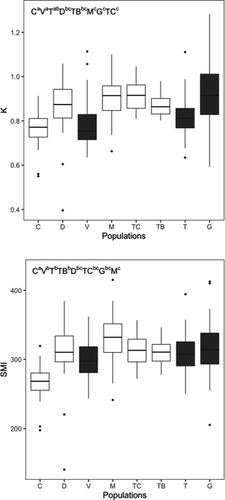当前位置:
X-MOL 学术
›
Ecol. Evol.
›
论文详情
Our official English website, www.x-mol.net, welcomes your
feedback! (Note: you will need to create a separate account there.)
Condition and size of the non-native pikeperch Sander lucioperca (Linnaeus, 1758) in Portuguese river basins
Ecology and Evolution ( IF 2.3 ) Pub Date : 2021-04-06 , DOI: 10.1002/ece3.7394 João Gago 1, 2 , Ana Neves 2 , Christos Gkenas 2 , Diogo Ribeiro 2 , Filipe Ribeiro 2
Ecology and Evolution ( IF 2.3 ) Pub Date : 2021-04-06 , DOI: 10.1002/ece3.7394 João Gago 1, 2 , Ana Neves 2 , Christos Gkenas 2 , Diogo Ribeiro 2 , Filipe Ribeiro 2
Affiliation

|
We studied life-history traits focusing on the growth and condition of the pikeperch Sander lucioperca to evaluate its phenotypic plasticity when introduced to new environments. Pikeperch is a non-native fish introduced to Iberian freshwater fauna in 1998 that quickly spread to other river basins through human-mediated activities, occupying now a wide variety of habitats along mainland Portugal. Condition (K and SMI), fork length at age, and length–weight relationships were studied for Portuguese populations. Pikeperch fork length for ages 1, 2, 3, and 4 was different between several populations. We applied generalized linear models (GLM) to study the influence of habitat type, latitude, altitude, time after first detection, and fish prey richness on pikeperch populations size at age 4 and condition. We observed higher condition values on populations from lower altitudes at lentic systems more recently introduced. But higher fork length at age 4 was found in populations from higher altitudes, on older populations with higher prey richness. Habitat type, time since first detection, and fish fauna composition are discussed as the main environmental factors explaining the observed phenotypic plasticity with concerns on predatory impact on native fauna.
中文翻译:

葡萄牙河流域非本地梭鲈 Sander lucioperca (Linnaeus, 1758) 的状况和大小
我们研究了梭鲈的生活史特征,重点关注梭鲈的生长和状况,以评估其在引入新环境时的表型可塑性。梭鲈是一种非本地鱼类,于 1998 年引入伊比利亚淡水动物群,通过人类活动迅速传播到其他河流流域,现已占据葡萄牙大陆沿线的各种栖息地。研究了葡萄牙人群的状况( K和 SMI)、年龄时的叉长度以及身长与体重的关系。梭鲈在 1、2、3 和 4 龄时的叉子长度在不同种群之间是不同的。我们应用广义线性模型(GLM)来研究栖息地类型、纬度、海拔、首次发现后的时间以及鱼类猎物丰富度对梭鲈 4 龄种群规模和状况的影响。我们在最近引入的静默系统中观察到来自较低海拔地区的种群的状况值较高。但在海拔较高的种群以及猎物丰富度较高的老年种群中,4岁时的叉子长度更长。栖息地类型、首次检测以来的时间和鱼类区系组成被讨论为解释观察到的表型可塑性的主要环境因素,并关注对本地动物区系的捕食影响。
更新日期:2021-05-19
中文翻译:

葡萄牙河流域非本地梭鲈 Sander lucioperca (Linnaeus, 1758) 的状况和大小
我们研究了梭鲈的生活史特征,重点关注梭鲈的生长和状况,以评估其在引入新环境时的表型可塑性。梭鲈是一种非本地鱼类,于 1998 年引入伊比利亚淡水动物群,通过人类活动迅速传播到其他河流流域,现已占据葡萄牙大陆沿线的各种栖息地。研究了葡萄牙人群的状况( K和 SMI)、年龄时的叉长度以及身长与体重的关系。梭鲈在 1、2、3 和 4 龄时的叉子长度在不同种群之间是不同的。我们应用广义线性模型(GLM)来研究栖息地类型、纬度、海拔、首次发现后的时间以及鱼类猎物丰富度对梭鲈 4 龄种群规模和状况的影响。我们在最近引入的静默系统中观察到来自较低海拔地区的种群的状况值较高。但在海拔较高的种群以及猎物丰富度较高的老年种群中,4岁时的叉子长度更长。栖息地类型、首次检测以来的时间和鱼类区系组成被讨论为解释观察到的表型可塑性的主要环境因素,并关注对本地动物区系的捕食影响。











































 京公网安备 11010802027423号
京公网安备 11010802027423号